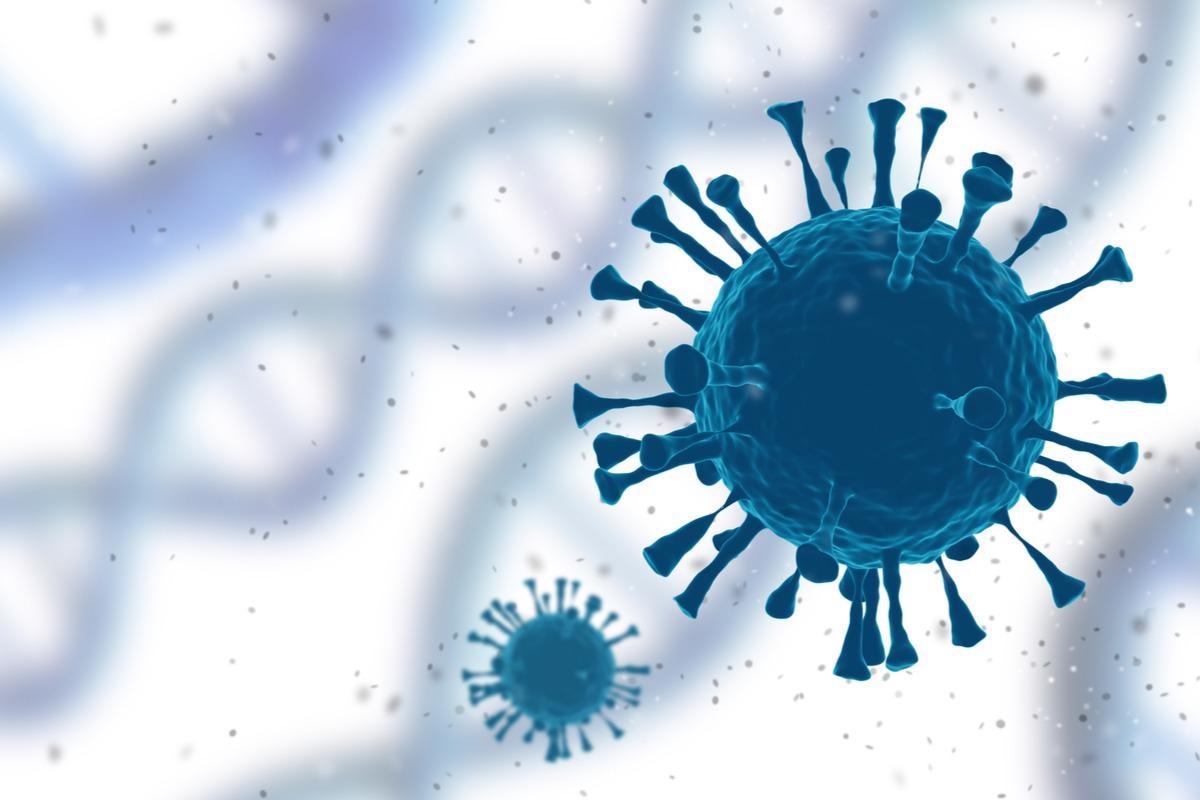In a recent review published in Mutation Research/Reviews in Mutation Research, researchers described potential mechanisms of coronaviruses that could lead to deoxyribonucleic acid (DNA) damage and the potential link between severe acute respiratory syndrome coronavirus 2 (SARS-CoV-2) activity and such mechanisms.
 Study: The potential role of COVID-19 in the induction of DNA damage. Image Credit: FOTOGRIN/Shutterstock
Study: The potential role of COVID-19 in the induction of DNA damage. Image Credit: FOTOGRIN/Shutterstock
Background
Coronavirus disease 2019 (COVID-19) patients may develop lymphopenia, elevated levels of alanine aminotransferase and C-reactive protein (CRP), and pulmonary alterations. Cases of long COVID have increased, and COVID-19 symptoms have been reported to occur irrespective of COVID-19 severity. SARS-CoV-2 could become endemic to human beings, and therefore, understanding the long-term consequences of COVID-19 is essential.
In the present review, researchers explored the role of SARS-CoV-2 in the induction of DNA damage, which could contribute to the long-term consequences of COVID-19 in humans.
Key aspects of SARS-CoV-2 biology
SARS-CoV-2 is highly homologous to the bat coronavirus RaTG13, and the receptor-binding motif (RBM) of the SARS-CoV-2 spike (S) protein, which recognizes human angiotensin-converting enzyme 2 (ACE2) receptor, shares high homology with pangolin coronaviruses. This indicates that SARS-CoV-2 probably originated from recombination between the pangolin and bat coronaviruses.
The SARS-CoV-2 genome consists of open reading frames 1a and 1b (ORF1a and ORF1b), which translate into two polypeptide molecules, and their cleavage results in the formation of non-structural proteins (nsp). In addition, SARS-CoV-2 RNA serves as a template for viral replication mediated by RNA-dependent RNA polymerase (RdRp) nsp12.
SARS-CoV-2 S1 RBM binds to ACE2 of the host, following which virions endocytosis and SARS-CoV-2 membrane fusion with the cell membrane takes place, releasing SARS-CoV-2 intracellularly. S protein cleavage by the transmembrane protease serine 2 (TMPRSS2) facilitates the endocytosis. Membrane fusion releases SARS-CoV-2 genomic RNA (gRNA) in the cytosol, facilitating SARS-CoV-2 genome replication.
Direct ways of probable DNA injury by coronaviruses
Nsp13 from related coronaviruses such as SARS-CoV and infectious bronchitis virus (IBV) impair DNA polymerase δ activity, leading to DNA replication fork stress, DNA damage, histone, and H2AX (H2A histone family member X) phosphorylation, and arrest of the cell cycle. Importantly, the nsp13 of SARS-CoV and SARS-CoV-2 are 99.8 % similar, indicating that this mechanism could similarly be induced by the novel SARS-CoV-2. SARS-CoV-2 infections induce overexpression of ATR (Ataxia telangiectasia and Rad3-related) and CHK1 (checkpoint kinase 1) and telomere shortening.
The tumor suppressor gene p53 primarily regulates the cell cycle, genomic stability, and the inhibition of replication of viruses. Nsp3 protein encoded by SARS-CoV, Middle East respiratory syndrome coronavirus (MERS-CoV), and the human coronavirus (HCoV)-NL63 promotes p53 degradation and dysregulation. Of note, nsp3 of SARS-CoV and SARS-CoV-2 is similar, the degree of p53 dysregulation could also be similar between the viruses. The degradation of p53 could deregulate the APOBEC3B (apolipoprotein B mRNA editing enzyme catalytic subunit 3b) gene and cytidine deaminase enzymes, resulting in genomic instability.
SARS-CoV nucleoprotein (N) induces the overexpression of the cyclooxygenase-2 (COX2) in pulmonary cells and contributes to the transcription and binding of NF-κB (nuclear factor kappa B) and C/EBP (CCAAT-enhancer-binding proteins) binding regions of the COX2 promoter. COX2 enhances genetic instability and DNA injury by the induction of DNA adducts and by influencing the cellular expression of glutathione. In addition, COX2 leads to prostaglandin E2 production, which enhances the pro-inflammatory state and can lead to exacerbations of pro-oxidant conditions and induce DNA damage.
Nsp1 protein can interact with DNA polymerase α enzyme subunits, thus altering DNA synthesis and regulation of cell cycle, and can impair DNA repair processes. Furthermore, Nsp13 of SARS-CoV-2 has been found to interact with multiple centrosome proteins and disrupt centrosome duplication and/or structure can give rise to genomic instability by facilitating aneugenic pathways, which result in alterations in chromosome structure and number.
Indirect ways of probable DNA injury by SARS-CoV-2
COVID-19 severity is characterized by overexpression of interleukin-6 (IL-6) and CRP levels. High CRP levels have been associated with increased oxidative damage in the DNA of individuals with obesity, psoriasis, obesity, cardiovascular disorders, and pancreatic cancer. Chronic and aberrant inflammation also leads to reactive oxygen species (ROS) overexpression. Individuals with severe SARS-CoV-2 infections have a pro-inflammatory and pro-oxidative state.
In SARS-CoV-2-positive individuals, serum glutathione levels and total thiol levels are reduced. In contrast, catalase superoxide dismutase (SOD) and malondialdehyde (associated with lipid peroxidation and oxidative stress) levels and the total oxidant levels are increased with a substantial upregulation or increase in pro-oxidant gene expression, primarily the calprotectin myeloperoxidase (MPO) and genes.
Increased levels of oxidative stress can induce various types of DNA injury, such as breaks in single- and double strands of DNA, cross-linkage of DNA and proteins, and the formation of several products of oxidation of nucleic acid constituent bases and sugars, for example, the generation of guanine oxidized species (GOS).
Taken together, the findings highlight the possibilities for SARS-CoV-2 to impair DNA repair mechanisms, induce DNA damage, and induce oxidative stress in human cells and show that COVID-19 can be a multisystemic disease that could have long-lasting effects on the affected organs.